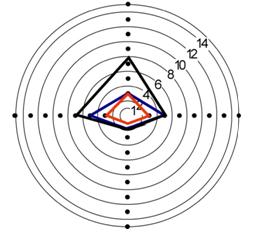|
Adheremeter
Adheremeter is a new device designed to measure adherence of postsurgical scar which is defined as the restriction of scar mobility with respect to underlying tissue of the worst adherent point when stretched in four orthogonal directions. It is a cheap and easy-to-use instrument with ergonomic shape, consisting of 9 concentric rings with radii of 1, 2, 4, 6, 8, 10, 12, 14, and 15 mm, respectively, printed on flexible transparency film for copiers (Manufacturer Part Number PP2500 - 3MTM, St. Paul, MN, USA) to ensure maximum adaptability to different anatomical surfaces.
Adheremeter in 100% proportion:
Background and Purpose
Scarring after surgery can lead to a wide range of disorders. At present, the degree of scar adhesion is assessed manually and by ordinal scales. Adheremeter is a device that objectively measures scar adhesion. It showed to be reliable and valid* and is useful for who needs to evaluate if scar is improving after physical therapy treatment.
*Physical Therapy 2010;90(5):776-783
Giorgio Ferriero, Stefano Vercelli, Ludovit Salgovic, Valeria Stissi, and Francesco Sartorio
VALIDATION OF A NEW DEVICE TO MEASURE POSTSURGICAL SCAR ADHERENCE
How to use Adheremeter
Clinician identifies the worst adherent point and the skin on the contralateral anatomic position of the adherence, and marks them with a fineliner pen (as landmarks).
Both surfaces must be cleaned. In linear scars, the rater reports on the patient record the position of the worst adherent point by measuring its distance from two extremities of the scar.
Positioning on skin:
- rings of the Adheremeter are centered on the landmark
- skin is relaxed and nearby joints are in loose packed position
- The clinitian holds the device in the hand, supporting the hand on the patient's body in such a way tha there is no contact between the Adherementer and the patient's skin. Other thumb is positioned close to the external edge of the device (17.5 mm from the center). Before stretching the skin with the thumb with maximal force within a comfortable range for the patient, the rater says to the patient: "Now, I'm beginning to stretch the skin; if you feel any discomfort, let me know immediately".
Traction is applied centrifugally in four directions: caudal, rostral, right side, and left side. For every traction, the rater reads on the Adheremeter the position of the landmark at the maximal excursion. Once the tension is released, the rater verifies that the landmark returns to the Adheremeter's center, and, if not, repeats the measurement. The whole procedure generally takes a few minutes per landmark.

The score of each index of surface mobility is obtained calculating the area of the quadrilateral whose diagonals, which are orthogonal to each other, are the side - to- side and rostrocaudal landmark maximal excursions.

Indices
4 measurements (i.e rostral, caudal and the two side maximal landmark excursions from the rest position), taken both for the scar and for the normal contralateral skin, are used to obtain a couple of indices of surface mobility:
1. surface mobility index for the scar (SMA),
2. surface mobility index for the normal contralateral skin (SMN).
The index of adherence severity (AS)
The index of adherence severity (AS) estimates the ratio between SMA and SMN: AS=SMA/SMN

Its values thus calculated range from 0 to 1, where 0 represents scar immobility in at least one diagonal (side-to-side and/or rostrocaudal), and 1 represents completely normal scar mobility.
In both indices an increase of values means a better scar condition: i.e. for SMA a higher surface mobility, for AS a scar surface mobility approaching that of normal skin.
|




